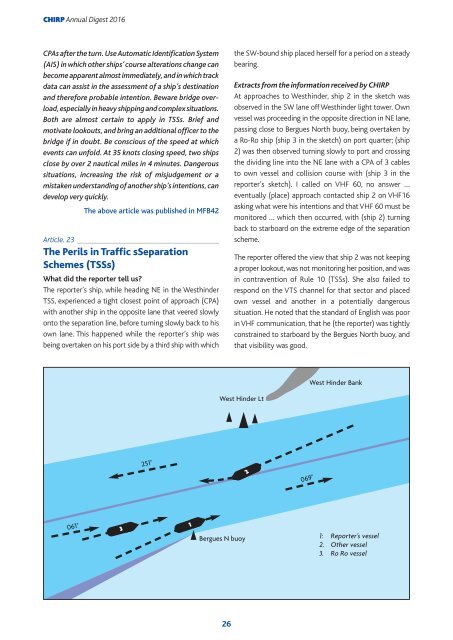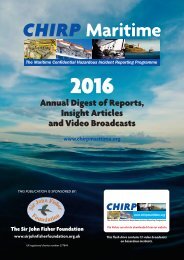CHIRP annual digest 2016 6th
You also want an ePaper? Increase the reach of your titles
YUMPU automatically turns print PDFs into web optimized ePapers that Google loves.
<strong>CHIRP</strong> Annual Digest <strong>2016</strong><br />
CPAs after the turn. Use Automatic Identification System<br />
(AIS) in which other ships’ course alterations change can<br />
become apparent almost immediately, and in which track<br />
data can assist in the assessment of a ship’s destination<br />
and therefore probable intention. Beware bridge over -<br />
load, especially in heavy shipping and complex situations.<br />
Both are almost certain to apply in TSSs. Brief and<br />
motivate lookouts, and bring an additional officer to the<br />
bridge if in doubt. Be conscious of the speed at which<br />
events can unfold. At 35 knots closing speed, two ships<br />
close by over 2 nautical miles in 4 minutes. Dangerous<br />
situations, increasing the risk of misjudgement or a<br />
mistaken understanding of another ship’s intentions, can<br />
develop very quickly.<br />
The above article was published in MFB42<br />
Article. 23<br />
The Perils in Traffic sSeparation<br />
Schemes (TSSs)<br />
What did the reporter tell us?<br />
The reporter’s ship, while heading NE in the Westhinder<br />
TSS, experienced a tight closest point of approach (CPA)<br />
with another ship in the opposite lane that veered slowly<br />
onto the separation line, before turning slowly back to his<br />
own lane. This happened while the reporter’s ship was<br />
being overtaken on his port side by a third ship with which<br />
the SW-bound ship placed herself for a period on a steady<br />
bearing.<br />
Extracts from the information received by <strong>CHIRP</strong><br />
At approaches to Westhinder, ship 2 in the sketch was<br />
observed in the SW lane off Westhinder light tower. Own<br />
vessel was proceeding in the opposite direction in NE lane,<br />
passing close to Bergues North buoy, being overtaken by<br />
a Ro-Ro ship (ship 3 in the sketch) on port quarter; (ship<br />
2) was then observed turning slowly to port and crossing<br />
the dividing line into the NE lane with a CPA of 3 cables<br />
to own vessel and collision course with (ship 3 in the<br />
reporter’s sketch). I called on VHF 60, no answer …<br />
eventually (place) approach contacted ship 2 on VHF16<br />
asking what were his intentions and that VHF 60 must be<br />
monitored … which then occurred, with (ship 2) turning<br />
back to starboard on the extreme edge of the separation<br />
scheme.<br />
The reporter offered the view that ship 2 was not keeping<br />
a proper lookout, was not monitoring her position, and was<br />
in contravention of Rule 10 (TSSs). She also failed to<br />
respond on the VTS channel for that sector and placed<br />
own vessel and another in a potentially dangerous<br />
situation. He noted that the standard of English was poor<br />
in VHF communication, that he (the reporter) was tightly<br />
constrained to starboard by the Bergues North buoy, and<br />
that visibility was good.<br />
West Hinder Bank<br />
West Hinder Lt<br />
251°<br />
2<br />
069°<br />
061°<br />
3<br />
1<br />
Bergues N buoy<br />
1: Reporter’s vessel<br />
2. Other vessel<br />
3. Ro Ro vessel<br />
26



